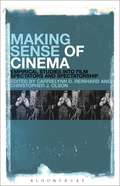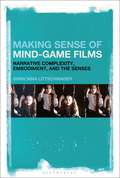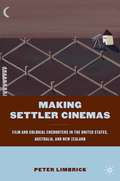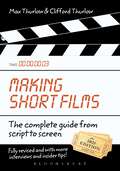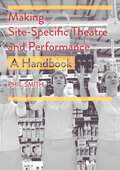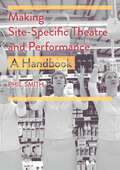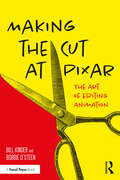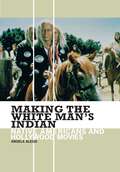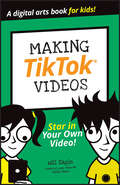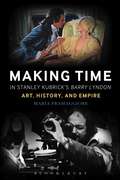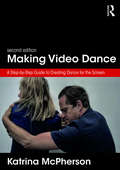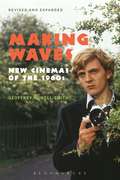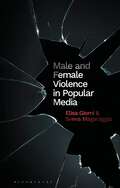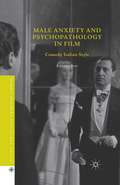- Table View
- List View
Making Sense of Cinema: Empirical Studies into Film Spectators and Spectatorship
by Christopher J. Olson Edited by CarrieLynn D. ReinhardThere are a variety of theoretical and methodological approaches to researching how film spectators make sense of film texts, from the film text itself, the psychological traits and sociocultural group memberships of the viewer, or even the location and surroundings of the viewer. However, we can only understand the agency of film spectators in situations of film spectatorship by studying actual spectators' interactions with specific film texts in specific contexts of engagement.Making Sense of Cinema: Empirical Studies into Film Spectators and Spectatorship uses a number of empirical approaches (ethnography, focus groups, interviews, historical, qualitative experiment and physiological experiment) to consider how the film spectator makes sense of the text itself or the ways in which the text fits into his or her everyday life. With case studies ranging from preoccupations of queer and ageing men in Spanish and French cinema and comparative eye-tracking studies based on the two completely different soundscapes of Monsters Inc. and Saving Private Ryan to cult fanbase of the Lord of the Rings Trilogy and attachment theory to its fictional characters, Making Sense of Cinema aligns this subset of film studies with the larger fields of media reception studies, allowing for dialogue with the broader audience and reception studies field.
Making Sense of Cinema: Empirical Studies into Film Spectators and Spectatorship
by CarrieLynn D. Reinhard Christopher J. OlsonThere are a variety of theoretical and methodological approaches to researching how film spectators make sense of film texts, from the film text itself, the psychological traits and sociocultural group memberships of the viewer, or even the location and surroundings of the viewer. However, we can only understand the agency of film spectators in situations of film spectatorship by studying actual spectators' interactions with specific film texts in specific contexts of engagement.Making Sense of Cinema: Empirical Studies into Film Spectators and Spectatorship uses a number of empirical approaches (ethnography, focus groups, interviews, historical, qualitative experiment and physiological experiment) to consider how the film spectator makes sense of the text itself or the ways in which the text fits into his or her everyday life. With case studies ranging from preoccupations of queer and ageing men in Spanish and French cinema and comparative eye-tracking studies based on the two completely different soundscapes of Monsters Inc. and Saving Private Ryan to cult fanbase of the Lord of the Rings Trilogy and attachment theory to its fictional characters, Making Sense of Cinema aligns this subset of film studies with the larger fields of media reception studies, allowing for dialogue with the broader audience and reception studies field.
Making Sense of Mind-Game Films: Narrative Complexity, Embodiment, and the Senses
by Simin Nina LittschwagerMind-game films and other complex narratives have been a prominent phenomenon of the cinematic landscape during the period 1990-2010, when films like The Sixth Sense, Memento, Fight Club and Source Code became critical and commercial successes, often acquiring a cult status with audiences. With their multiple story lines, unreliable narrators, ambiguous twist endings, and paradoxical worlds, these films challenge traditional ways of narrative comprehension and in many cases require and reward multiple viewings. But how can me make sense of films that don't always make sense the way we are used to? While most scholarship has treated these complex films as narrative puzzles that audiences solve with their cognitive skills, Making Sense of Mind-Game Films offers a fresh perspective by suggesting that they appeal to the body and the senses in equal measures. Mind-game films tell stories about crises between body, mind and world, and about embodied forms of knowing and subjective ways of being-in-the-world. Through compelling in-depth case studies of popular mind-game films, the book explores how these complex narratives take their (embodied) spectators with them into such crises. The puzzling effect generated by these films stems from a conflict between what we think and what we experience, between what we know and what we feel to be true, and between what we see and what we sense.
Making Sense of Mind-Game Films: Narrative Complexity, Embodiment, and the Senses
by Simin Nina LittschwagerMind-game films and other complex narratives have been a prominent phenomenon of the cinematic landscape during the period 1990-2010, when films like The Sixth Sense, Memento, Fight Club and Source Code became critical and commercial successes, often acquiring a cult status with audiences. With their multiple story lines, unreliable narrators, ambiguous twist endings, and paradoxical worlds, these films challenge traditional ways of narrative comprehension and in many cases require and reward multiple viewings. But how can me make sense of films that don't always make sense the way we are used to? While most scholarship has treated these complex films as narrative puzzles that audiences solve with their cognitive skills, Making Sense of Mind-Game Films offers a fresh perspective by suggesting that they appeal to the body and the senses in equal measures. Mind-game films tell stories about crises between body, mind and world, and about embodied forms of knowing and subjective ways of being-in-the-world. Through compelling in-depth case studies of popular mind-game films, the book explores how these complex narratives take their (embodied) spectators with them into such crises. The puzzling effect generated by these films stems from a conflict between what we think and what we experience, between what we know and what we feel to be true, and between what we see and what we sense.
Making Sense of Mind-Game Films: Narrative Complexity, Embodiment, and the Senses
by Simin Nina LittschwagerMind-game films and other complex narratives have been a prominent phenomenon of the cinematic landscape during the period 1990-2010, when films like The Sixth Sense, Memento, Fight Club and Source Code became critical and commercial successes, often acquiring a cult status with audiences. With their multiple story lines, unreliable narrators, ambiguous twist endings, and paradoxical worlds, these films challenge traditional ways of narrative comprehension and in many cases require and reward multiple viewings. But how can me make sense of films that don't always make sense the way we are used to? While most scholarship has treated these complex films as narrative puzzles that audiences solve with their cognitive skills, Making Sense of Mind-Game Films offers a fresh perspective by suggesting that they appeal to the body and the senses in equal measures. Mind-game films tell stories about crises between body, mind and world, and about embodied forms of knowing and subjective ways of being-in-the-world. Through compelling in-depth case studies of popular mind-game films, the book explores how these complex narratives take their (embodied) spectators with them into such crises. The puzzling effect generated by these films stems from a conflict between what we think and what we experience, between what we know and what we feel to be true, and between what we see and what we sense.
Making Sense of Mind-Game Films: Narrative Complexity, Embodiment, and the Senses
by Simin Nina LittschwagerMind-game films and other complex narratives have been a prominent phenomenon of the cinematic landscape during the period 1990-2010, when films like The Sixth Sense, Memento, Fight Club and Source Code became critical and commercial successes, often acquiring a cult status with audiences. With their multiple story lines, unreliable narrators, ambiguous twist endings, and paradoxical worlds, these films challenge traditional ways of narrative comprehension and in many cases require and reward multiple viewings. But how can me make sense of films that don't always make sense the way we are used to? While most scholarship has treated these complex films as narrative puzzles that audiences solve with their cognitive skills, Making Sense of Mind-Game Films offers a fresh perspective by suggesting that they appeal to the body and the senses in equal measures. Mind-game films tell stories about crises between body, mind and world, and about embodied forms of knowing and subjective ways of being-in-the-world. Through compelling in-depth case studies of popular mind-game films, the book explores how these complex narratives take their (embodied) spectators with them into such crises. The puzzling effect generated by these films stems from a conflict between what we think and what we experience, between what we know and what we feel to be true, and between what we see and what we sense.
Making Settler Cinemas: Film and Colonial Encounters in the United States, Australia, and New Zealand
by P. LimbrickThrough a shrewd analysis of the historical experience of imperialism and settler colonialism, Limbrick draws new conclusions about their effect on cinematic production, distribution, reception and filmic discourse.
Making Short Films, Third Edition: The Complete Guide from Script to Screen
by Clifford Thurlow Max ThurlowMaking movies is the most exciting way to earn a living and it is not surprising that media and film studies remain the most popular courses at colleges across the western world. A short film provides an opportunity for elliptical, poetic, condensed story telling. Shorts can take risks rarely seen in features. It is the arena where a strong voice or individual vision is possible; an invitation for experimentation and originality. Making Short Films, 3rd edition is entirely revised and restructured, providing a much more complete and detailed guide to filmmaking, with more information on new technology, illustrations and ideas for best practice.
Making Short Films, Third Edition: The Complete Guide from Script to Screen
by Clifford Thurlow Max ThurlowMaking movies is the most exciting way to earn a living and it is not surprising that media and film studies remain the most popular courses at colleges across the western world. A short film provides an opportunity for elliptical, poetic, condensed story telling. Shorts can take risks rarely seen in features. It is the arena where a strong voice or individual vision is possible; an invitation for experimentation and originality. Making Short Films, 3rd edition is entirely revised and restructured, providing a much more complete and detailed guide to filmmaking, with more information on new technology, illustrations and ideas for best practice.
Making Site-Specific Theatre and Performance: A Handbook
by Phil SmithThis practical, accessible and far-reaching guide to making site-specific theatre and performance emphasises the diversity of approaches to the practice, and explores key principles of space and site. Phil Smith draws on a wide range of interdisciplinary and international performance examples, and uses an innovative variety of exercises, to show students and aspiring performance-makers how to find a site and generate a performance beyond the theatre building.
Making Site-Specific Theatre and Performance: A Handbook
by Phil SmithThis practical, accessible and far-reaching guide to making site-specific theatre and performance emphasises the diversity of approaches to the practice, and explores key principles of space and site. Phil Smith draws on a wide range of interdisciplinary and international performance examples, and uses an innovative variety of exercises, to show students and aspiring performance-makers how to find a site and generate a performance beyond the theatre building.
Making the Cut at Pixar: The Art of Editing Animation
by Bill Kinder Bobbie O'SteenJoin industry insiders Bill Kinder and Bobbie O’Steen as they guide readers on a journey through every stage of production on an animated film, from storyboards to virtual cameras and final animation. With unprecedented access to the Pixar edit suite, this authoritative project highlights the central role film editors play in some of the most critically acclaimed and commercially successful movies of all time. Exclusive interviews with animation editors and other creative leads are supported by footage from deep inside Pixar’s vault. Nearly 90 minutes of video segments include never-before-seen works in progress, deleted scenes, and demonstrations to shed light on how these beloved stories are crafted. The challenges and essential contributions of editors in animation have never been examined in such depth and detail. In addition to exploring method and craft, this book provides important context for the editor in animation history, the evolution of technology, and Pixar’s uniquely collaborative studio culture. A must-read for students of digital filmmaking, filmmakers in all aspects of production, and fans of Pixar movies.
Making the Cut at Pixar: The Art of Editing Animation
by Bill Kinder Bobbie O'SteenJoin industry insiders Bill Kinder and Bobbie O’Steen as they guide readers on a journey through every stage of production on an animated film, from storyboards to virtual cameras and final animation. With unprecedented access to the Pixar edit suite, this authoritative project highlights the central role film editors play in some of the most critically acclaimed and commercially successful movies of all time. Exclusive interviews with animation editors and other creative leads are supported by footage from deep inside Pixar’s vault. Nearly 90 minutes of video segments include never-before-seen works in progress, deleted scenes, and demonstrations to shed light on how these beloved stories are crafted. The challenges and essential contributions of editors in animation have never been examined in such depth and detail. In addition to exploring method and craft, this book provides important context for the editor in animation history, the evolution of technology, and Pixar’s uniquely collaborative studio culture. A must-read for students of digital filmmaking, filmmakers in all aspects of production, and fans of Pixar movies.
Making the White Man's Indian: Native Americans and Hollywood Movies (Non-ser.)
by Angela AleissThe image in Hollywood movies of savage Indians attacking white settlers represents only one side of a very complicated picture. In fact sympathetic portrayals of Native Americans stood alongside those of hostile Indians in the silent films of D. W. Griffith and Cecil B. DeMille, and flourished during the early 1930s with Hollywood's cycle of pro-Indian adventures. Decades later, the stereotype became even more complicated, as films depicted the savagery of whites (The Searchers) in contrast to the more peaceful Indian (Broken Arrow). By 1990 the release of Dances with Wolves appeared to have recycled the romantic and savage portrayals embedded in early cinema. In this new study, author Angela Aleiss traces the history of Native Americans on the silver screen, and breaks new ground by drawing on primary sources such as studio correspondence, script treatments, trade newspapers, industry censorship files, and filmmakers' interviews to reveal how and why Hollywood created its Indian characters. Behind-the-scenes anecdotes of filmmakers and Native Americans, as well as rare archival photographs, supplement the discussion, which often shows a stark contrast between depiction and reality.The book traces chronologically the development of the Native American's screen image while also examining many forgotten or lost Western films. Each chapter will feature black and white stills from the films discussed.
Making TikTok Videos (Dummies Junior)
by Will Eagle Hannah Budke Claire Cohen Andrew Cooper Jordan Elijah Michael Andrew PanturescuCreate videos using the tricks of TikTok stars! Making TikTok Videos reveals the secrets that TikTok celebs and influencers use to make the videos that everyone’s watching. Hilarious clips, the latest dances, instruction videos—whatever you want to do, make sure it shows off the latest TikTok styles. This book shows you how to use whatever you have on hand to record, edit, and upload TikToks. Add music and text, get creative, and start sharing your finished products. With this guide, you’ll get easy instructions on how to make videos that people remember. You also get some tips on how to bring viewers to your account. Use your mobile device to shoot videos with top-notch sound Learn the editing tricks TikTok pros use to create a finished video Set up your TikTok account and set your privacy Keep up with the latest TikTok video stylesWritten especially for the 10-14 age group interested in creating their first TikTok videos, this Dummies Jr. title will help you get plugged into the TikTok universe.
Making TikTok Videos (Dummies Junior)
by Will Eagle Hannah Budke Claire Cohen Andrew Cooper Jordan Elijah Michael Andrew PanturescuCreate videos using the tricks of TikTok stars! Making TikTok Videos reveals the secrets that TikTok celebs and influencers use to make the videos that everyone’s watching. Hilarious clips, the latest dances, instruction videos—whatever you want to do, make sure it shows off the latest TikTok styles. This book shows you how to use whatever you have on hand to record, edit, and upload TikToks. Add music and text, get creative, and start sharing your finished products. With this guide, you’ll get easy instructions on how to make videos that people remember. You also get some tips on how to bring viewers to your account. Use your mobile device to shoot videos with top-notch sound Learn the editing tricks TikTok pros use to create a finished video Set up your TikTok account and set your privacy Keep up with the latest TikTok video stylesWritten especially for the 10-14 age group interested in creating their first TikTok videos, this Dummies Jr. title will help you get plugged into the TikTok universe.
Making Time in Stanley Kubrick's Barry Lyndon: Art, History, and Empire
by Maria PramaggioreConsidered by critics to be Stanley Kubrick's masterpiece, Barry Lyndon has suffered from scholarly and popular neglect. Maria Pramaggiore argues that one key reason that this film remains unappreciated, even by Kubrick aficionados, is that its transnational and intermedial contexts have not been fully explored. Taking a novel approach, she looks at the film from a transnational perspective -- as a foreign production shot in Ireland and an adaptation of a British novel by an American director about an Irish subject. Pramaggiore argues that, in Barry Lyndon, Kubrick develops his richest philosophical mediation on cinema's capacity to mediate the real and foregrounds film's relationship to other technologies of visuality, including painting, photography, and digital media. By combining extensive research into the film's source novel, production and reception with systematic textual analysis and an engagement with several key issues in contemporary academic debate, this work promises not only to make a huge impact in the field of Kubrick studies, but also in 1970s filmmaking, cultural history and transnational film practice.
Making Time in Stanley Kubrick's Barry Lyndon: Art, History, and Empire
by Maria PramaggioreConsidered by critics to be Stanley Kubrick's masterpiece, Barry Lyndon has suffered from scholarly and popular neglect. Maria Pramaggiore argues that one key reason that this film remains unappreciated, even by Kubrick aficionados, is that its transnational and intermedial contexts have not been fully explored. Taking a novel approach, she looks at the film from a transnational perspective -- as a foreign production shot in Ireland and an adaptation of a British novel by an American director about an Irish subject. Pramaggiore argues that, in Barry Lyndon, Kubrick develops his richest philosophical mediation on cinema's capacity to mediate the real and foregrounds film's relationship to other technologies of visuality, including painting, photography, and digital media. By combining extensive research into the film's source novel, production and reception with systematic textual analysis and an engagement with several key issues in contemporary academic debate, this work promises not only to make a huge impact in the field of Kubrick studies, but also in 1970s filmmaking, cultural history and transnational film practice.
Making Video Dance: A Step-by-Step Guide to Creating Dance for the Screen (2nd ed)
by Katrina McPhersonMaking Video Dance: A Step-by-Step Guide to Creating Dance for the Screen is the first workbook to follow the entire process of video dance production: from having an idea, through to choreographing for the screen, filming and editing, and distribution. In doing so, it explores and analyses the creative, practical, technical, and aesthetic issues that arise when making screen dance. This rigorously revised edition brings the book fully up to date from a technical and aesthetic point of view, and includes: An extended exploration of improvisation in the video dance-making process New writing about filming in the landscape Additional writing on developing a practice and working with scores and manifestos Updated information about camera use, including filming with mobile phones A step-by-step guide to digital non-linear editing of screen dance Ideas for distribution in the 21st century Insights into Katrina’s own screen dance practice, with reference to specific works that she has directed and which are available to view online New and revised practical exercises New illustrations specially drawn for this edition
Making Video Dance: A Step-by-Step Guide to Creating Dance for the Screen (2nd ed)
by Katrina McPhersonMaking Video Dance: A Step-by-Step Guide to Creating Dance for the Screen is the first workbook to follow the entire process of video dance production: from having an idea, through to choreographing for the screen, filming and editing, and distribution. In doing so, it explores and analyses the creative, practical, technical, and aesthetic issues that arise when making screen dance. This rigorously revised edition brings the book fully up to date from a technical and aesthetic point of view, and includes: An extended exploration of improvisation in the video dance-making process New writing about filming in the landscape Additional writing on developing a practice and working with scores and manifestos Updated information about camera use, including filming with mobile phones A step-by-step guide to digital non-linear editing of screen dance Ideas for distribution in the 21st century Insights into Katrina’s own screen dance practice, with reference to specific works that she has directed and which are available to view online New and revised practical exercises New illustrations specially drawn for this edition
Making Waves, Revised and Expanded: New Cinemas of the 1960s
by Geoffrey Nowell-SmithThe 1960s was famously the decade of sex, drugs and rock'n'roll. It was also a decade of revolution and counter-revolution, of the Cuban missile crisis, of the American intervention in Vietnam, of economic booms and the beginning of consumerism (and the rebellion against it). In Hollywood, the genres which had held audiences captive in the 1940s and 50s - musicals, Westerns, melodramas - were losing their appeal and their great practitioners were approaching retirement. The scene was therefore set for new cinemas to emerge to attract the young, the discriminating, the politically conscious and the sexually emancipated.Making Waves, Revised and Expanded is a sharp, focused, and brilliant survey of the innovative filmmaking of the 1960s, placing it in its political, economic, cultural and aesthetic context - capturing the distinctiveness of a decade which was great for the cinema and for the world at large. Geoffrey Nowell-Smith pays particular attention to a handful of the most remarkable talents (Godard, Antonioni, Oshima) that emerged during the period and helped to make it so special. Nowell-Smith updates his classic text with a focus on 1960s Japan and the burgeoning New York scene.
Making Waves, Revised and Expanded: New Cinemas of the 1960s
by Geoffrey Nowell-SmithThe 1960s was famously the decade of sex, drugs and rock'n'roll. It was also a decade of revolution and counter-revolution, of the Cuban missile crisis, of the American intervention in Vietnam, of economic booms and the beginning of consumerism (and the rebellion against it). In Hollywood, the genres which had held audiences captive in the 1940s and 50s - musicals, Westerns, melodramas - were losing their appeal and their great practitioners were approaching retirement. The scene was therefore set for new cinemas to emerge to attract the young, the discriminating, the politically conscious and the sexually emancipated.Making Waves, Revised and Expanded is a sharp, focused, and brilliant survey of the innovative filmmaking of the 1960s, placing it in its political, economic, cultural and aesthetic context - capturing the distinctiveness of a decade which was great for the cinema and for the world at large. Geoffrey Nowell-Smith pays particular attention to a handful of the most remarkable talents (Godard, Antonioni, Oshima) that emerged during the period and helped to make it so special. Nowell-Smith updates his classic text with a focus on 1960s Japan and the burgeoning New York scene.
Male and Female Violence in Popular Media (Library of Gender and Popular Culture)
by Elisa Giomi Sveva MagaraggiaMale and Female Violence in Popular Media brings into focus the apparently symmetrical phenomena of men's violence against women and women's violence against men, explaining the profound differences in their actual features as well as in their representations, which over the last few years have been proliferating in a vast array of global media contents. Elisa Giomi and Sveva Magaraggia consider popular media including crime TV series such as The Killing (Denmark, 2007- 2012), The Fall (UK, 2013-2016) and True Detective (USA, 2015), factual entertainment such as Who the (bleep) Did I Marry? (Investigation Discovery, 2010-2015), and Italian pop music in order to examine popular culture's depictions of men and women in their opposite, yet complementary, roles of perpetrators and victims. They reveal how TV shows, pop-songs, news and commercials that populate global audiences' daily life fuel false beliefs about love and sexuality that either legitimate or stigmatise violence depending on the perpetrators and victims' gender.
Male and Female Violence in Popular Media (Library of Gender and Popular Culture)
by Elisa Giomi Sveva MagaraggiaMale and Female Violence in Popular Media brings into focus the apparently symmetrical phenomena of men's violence against women and women's violence against men, explaining the profound differences in their actual features as well as in their representations, which over the last few years have been proliferating in a vast array of global media contents. Elisa Giomi and Sveva Magaraggia consider popular media including crime TV series such as The Killing (Denmark, 2007- 2012), The Fall (UK, 2013-2016) and True Detective (USA, 2015), factual entertainment such as Who the (bleep) Did I Marry? (Investigation Discovery, 2010-2015), and Italian pop music in order to examine popular culture's depictions of men and women in their opposite, yet complementary, roles of perpetrators and victims. They reveal how TV shows, pop-songs, news and commercials that populate global audiences' daily life fuel false beliefs about love and sexuality that either legitimate or stigmatise violence depending on the perpetrators and victims' gender.
Male Anxiety and Psychopathology in Film: Comedy Italian Style (Italian and Italian American Studies)
by Andrea BiniThe most popular film genre during the golden years of Italian cinema, the Comedy Italian Style emerged after the fall of the Facist regime, narrating the identity crisis of many Italian men. Exploring the birth, growth, and decline of this genre, Bini shows this notable style was the search for a new role in the shattered postwar middle class.
